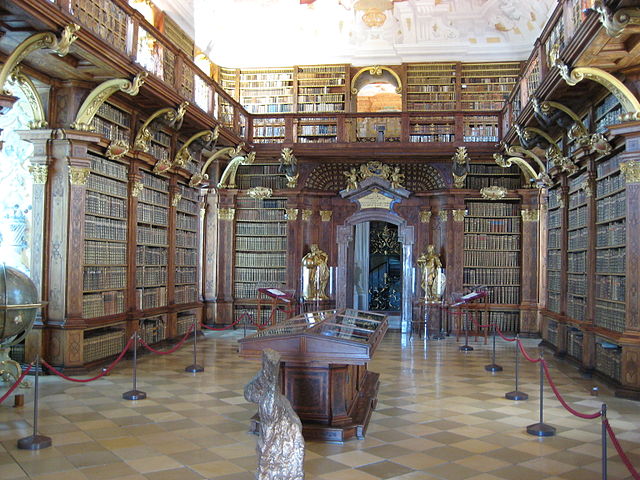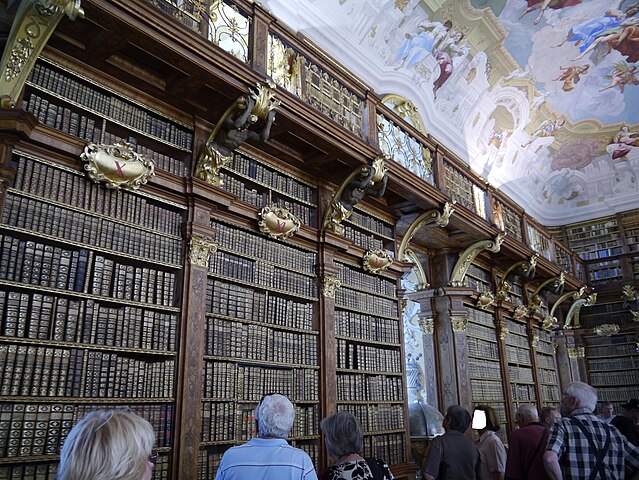Melk Monastery Library, Austria
Melk Abbey is in northeastern Austria, near the Danube River. A Benedictine Abbey was built above the town in the year 1089, but burned down in the 13th century. What survives today is an 18th century Baroque construction. Melk Abbey is a UNESCO World Heritage Site and is notable for its size and elegant decorations. Melk Abbey is one of Austria’s most popular tourist attractions in Austria, receiving almost 500, 000 visitors annually. In Umberto Eco’s bestselling novel and film The Name of the Rose, about medieval monks and their library, a character is named Adson von Melk in a reference to Melk Abbey. The abbey and its library within were built in 1736. Among the many visitors who have stayed at the abbey over the years are the composer Wolfgang Amadeus Mozart and Maria Theresa, Archduchess of Austria. In the Benedictine order, a division of the Roman Catholic church, libraries are very important. The many painted decorations at Melk show how the monks valued their library, associating it with such virtues as faith, wisdom, justice, strength, and temperance. They follow the Benedictine motto of ora et labora, a Latin phrase meaning pray and work. The library of the Melk abbey contains twelve rooms with almost 2000 manuscripts, 750 printed works before the year 1500, and many other books, adding up to a total of about 100,000. Its oldest book is from the year 988 CE, over 1100 years old. In the library room, books are divided by subject, including the Bible, theology, law, geography and astronomy, history, and dictionaries. A dramatic spiral staircase links the library to two reading rooms on higher floors. Because the architecture of the library was as important as the books, shelves at the top of the library hall are too narrow for books to fit on them. Rather than leave them empty, the 18th century designers preferred to put in fake books looking like the real thing, each one given a fake title and binding. Not all the rooms of the library are open to the public, since the buildings are still used by members of the church. In 1989 the abbey celebrated its 900th anniversary and now makes most of its annual income from tourism, agriculture, and forestry.

Preserving the manuscript treasures of Melk.
By the mid-1960s, the Melk Monastery Library still had no central heating or electric lights in the reading rooms. The Hill Museum & Manuscript Library (HMML) of Minnesota, a non-profit organization which digitizes ancient manuscripts from around the world, took an interest in this collection. HMML microfilmed their medieval manuscripts in 1965. To do so, staff had to carry heavy old books up two flights of circular staircases and along a mile-long corridor to get to the room where the microfilm equipment was set up. The librarians expected that one saint buried in the church would, according to tradition, lift the lid of his tomb to say hello to visitors.
Thailand and Austria
There is a long history of international exchange between Thailand and Austria. The 17th century Austrian explorer Christoph Carl Fernberger (1596-1653) visited Siam in the 1620s. His diary, discovered in 1972, claims that the women of Siam were always trying to meet and socialize with farang travellers. Fernberger arrived in the harbor of Ayutthaya in November 1624 during the reign of King Songtham of Ayutthaya, who ruled from 1620 to 1628. Today, some historians believe that Fernberger was the first Austrian to visit Ayutthaya and Pattani. The Nation reported in 2007 that Associate Professor Helmut Lukas, deputy director of the Austrian Academy of Sciences’ Institute for Social Anthropology, spoke about Fernberger’s diary at a Siam Society lecture organized in cooperation with Chulalongkorn University’s Centre for European Studies:
The Austrian visitor in Ayutthaya was impressed by the wealth of the kingdom and the wise rule of the Siamese king as well as his open door policy and strict law enforcement.
Dr. Lukas also pointed out that Fernberger’s view of the women of Ayutthaya was certainly mistaken:
Like any big port, Ayutthaya had a well-established prostitution ring catering to foreign seamen. But it would be wrong to assume that their behaviour was indicative of Thai women of that era…his pages on the women in Ayutthaya were based on his impressions of a very limited area, which he wrongly extrapolated to the entire country.
By contrast, Fernberger, was very impressed with Ratu Ungu, who ruled the Sultanate of Pattani as daughter of Sultan Mansur Shah. After being granted an audience with the ruler, Fernberger described her as an absolutist who did not listen to any advice from councillors. She enjoyed a royal entourage of 200 women and about 50 elephants, as well as the same number of husbands. As Dr. Lukas comments:
The gender equality in the old Pattani kingdom sets an example for modern times.
Austrian visitors after Fernberger
Many Austrian scientists during the 19th century took an interest in Siam, and Robert Heine-Geldern even invented the term Southeast Asia (Südostasien in German). He also co-founded what became the Southeast Asia Institute of New York and Berkeley, California. Thailand and Austria established a consular relationship in 1865, so this year is the 150th anniversary of this relationship. The first Austrian diplomat was sent here in 1867. Thai diplomats began going to Austria in 1883.The linguist Hugo Schuchardt was an early 20th century Austrian researcher who made many contributions to better understanding Thai culture. In the 1930s the Austrian anthropologist and photographer Hugo Adolf Bernatzik visited Thailand, taking a special interest in the Moken or chao le, the sea people who lead a nomadic, sea-based life on the coast and islands of the Andaman Sea on Thailand’s west coast, the provinces of Satun, Trang, Krabi, Phuket, Phang Nga, and Ranong, and the Mergui Archipelago of Myanmar. The Thammasat University Libraries own a copy of Bernatzik’s celebrated work The Spirits of the Yellow Leaves. This study of minorities in Thailand originally appeared in 1938. After the Second World War, Austrian scientists studied the hill tribes of Northern Thailand.
In 1961-62, Hans Manndorff, an Austrian anthropologist who would be named director of the Vienna’s Museum of Ethnology, worked for the United Nations on research and development in the highlands of Northern Thailand. His Socio-Economic Survey of Selected Hill Tribes in Northern Thailand was the first such government-funded study by the Public Welfare Department of the Ministry of Interior, assisted by the Asia Foundation. Over 800 ethnographic photographs were taken in Chiang Mai, Chiang Rai, and Tak provinces in Northern Thailand, focusing on the economic, social, and ritual activities of six Hill Tribes: the Lisu, Lahu, Akha, Hmong, Karen, and Yao.
Diplomatic exchanges.
On the official website of the Austrian Embassy to Thailand, it is noted that the Austrian Embassy in Bangkok opened in 1954. Among economic cooperation between the two countries is Austrian trains used for Bangkok’s Skytrain and subway. Thailand features around 110 Austrian sales and business offices, and a dozen joint-manufacturing ventures with Thai companies. The future may bring Austrian business involvement in such areas as infrastructure, environmental technology, water treatment, waste management, biodiesel, and medical technology in Thailand. The ASEAN European Academic University Network (ASEA-UNINET) is a network of European and South-East Asian universities, founded in Innsbruck, Austria in 1994. In 2004, to mark its 20th anniversary of bilateral exchange, HRH Princess Maha Chakri Sirindhorn visited the organization in Innsbruck. Earlier this year, His Excellency Mr. Enno Drofenik, current Austrian ambassador to Thailand told The Big Chilli:
We don’t really know how many Austrians live in Thailand. We always ask them to register with the embassy but not all do. Now we have about 600 people registered which cannot be correct. My guess is that around 3,000 Austrians reside in Thailand. Austria actually has a trade deficit with Thailand, meaning we import more than we export. Using last year’s figures, we imported goods valued at roughly €500 million (20.3 billion baht), while our exports amounted to about €280 million (11.4 billion baht). We mainly export machinery, green technology, medical equipment and chemicals. We import from Thailand textiles, cars, electronic parts and agricultural products like seafood and shrimp. Austrian companies have invested about €500 million here and they employ around 20,000 people. There are hundreds of small investors and big ones as well, for example in the rubber industry in the South. Another large investor is the famous crystal-maker Swarovski, which produces crystal products here. Last year about 110,000 Austrian tourists visited Thailand. About 37,000 Thai nationals visited Austria in 2013, which is a pretty decent number. They come mainly for our cultural heritage and natural beauty. They want to see the lakes and many go during winter to see the snow-covered mountains.

(all images courtesy of Wikimedia Commons)



